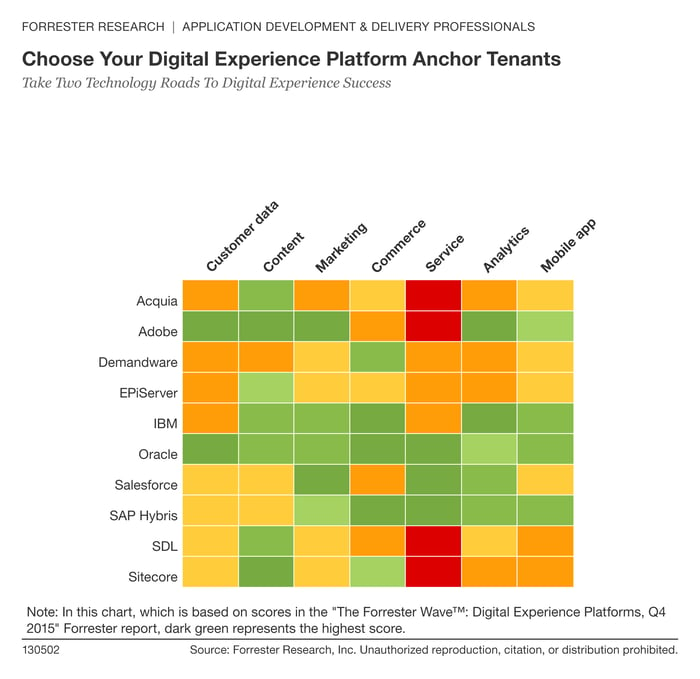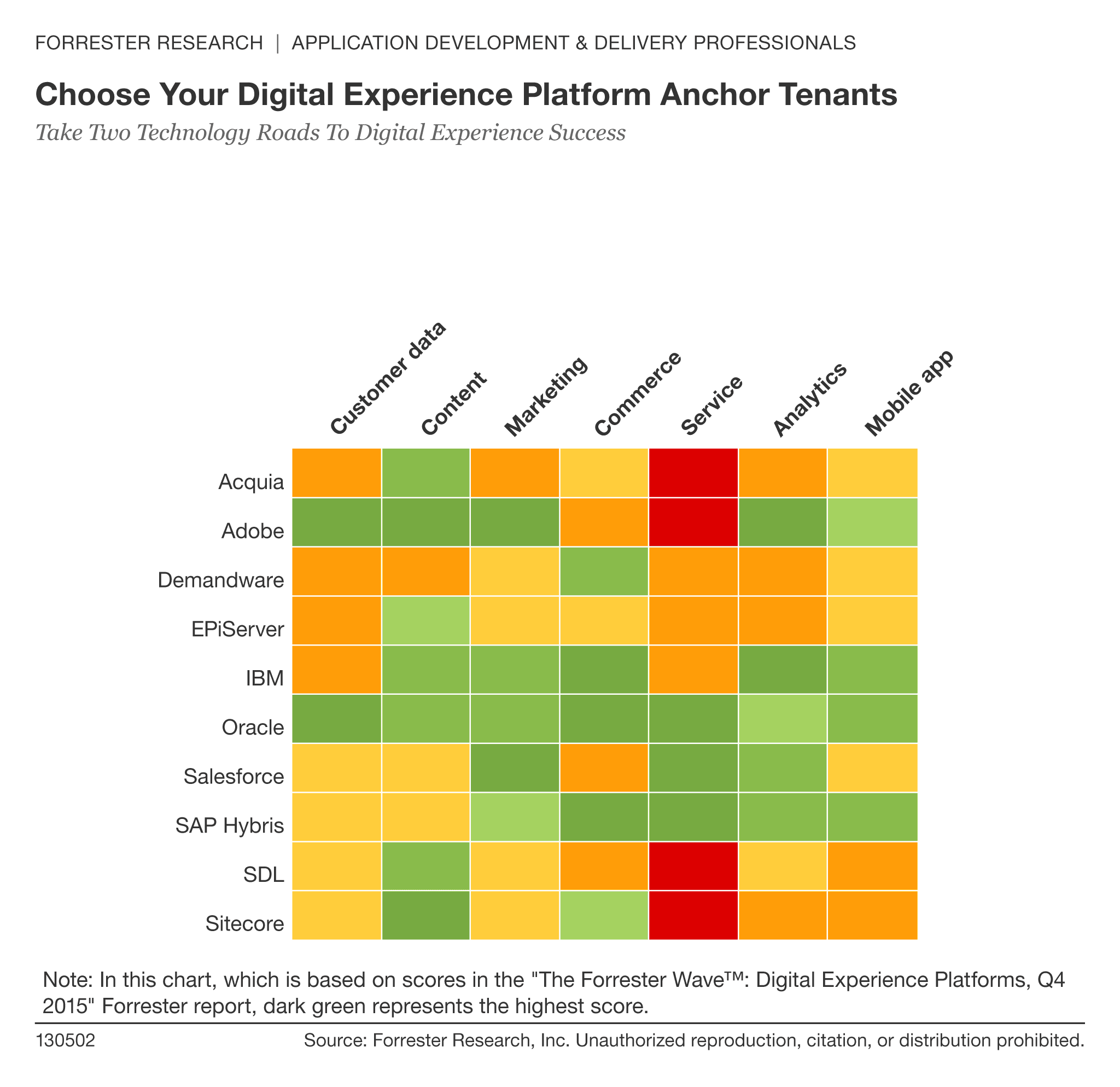What’s in a Digital Experience Platform?
Forrester analysts have been doing a great job of summarizing, categorizing and evaluating what’s going on in the world of digital customer experience management. Forrester defines the digital experience platform as, “Software to manage, deliver, and optimize experiences consistently across every digital touchpoint,” and that will address six key themes:
- Coordinate content, customer data, and core services to drive reuse and quality.
- Unify marketing, commerce, and service processes to improve practitioner workflows.
- Deliver contextually and share targeting rules to unify the experiences on every screen.
- Share front-end code across digital touchpoints to manage a common user experience.
- Link data and analytics to add insight and drive action.
- Manage code and extensions for maximum reuse while avoiding over-customization.
While Forrester has identified ten vendors that offer “digital experience platforms,” it’s important to understand that the large enterprise software portfolios we call digital experience (DX) platforms aren’t one-size-fits-all solutions. They’re really more like frameworks that provide many of the pieces enterprises need to manage customer experience (CX) through digital channels. Every organization will still need to customize and balance their CX management technology architecture by plugging in other solutions that address weaknesses and gaps in the off-the-shelf DX platforms they adopt.
Remember, the goal is to deliver a consistent, positive, personalized customer experience across any and all channels and touchpoints, including giving balanced attention and resources to Service and Commerce as well as Marketing. To get an idea of the kinds of holes you’re likely going to need to fill when supplementing an existing DX platform, adopting a DX platform for the first time, or replacing your DX delivery solution(s) entirely with a new approach, you’ll need to understand what current DX platforms include and where they fall short.
The Current DX Platform Landscape
In general, depending on the core focus and strength from which a vendor started their software development (Marketing, Commerce or Service), any enterprise DX platform you can buy today is going to be stronger in one or two areas and weaker in the others. More precisely, it’s highly likely to be heavy on the Marketing solutions, like web content management systems for content marketing, social listening and engagement dashboards, email marketing and tracking systems, and automated lead generation tools. That’s just where the DX market was born and developed for the most part. Marketing departments often “own” CX by default, and they also often have the largest budgets and most resources for customer and prospect outreach. So the DX platform vendors have naturally catered most strongly to the needs and demands of the acquisition side of customer experience.
In the past few years, DX platform vendors have recognized the need to support omnichannel customer interactions, data management and reporting beyond Marketing, and they have set about developing and acquiring broader portfolios of software solutions to address their gaps in Commerce and Service. Everyone is racing to put together the first comprehensive, truly end-to-end DX platform, but no one is there yet (or may ever be). But they are getting pretty big, with some combining dozens of (or more) individual applications in an attempt to cover every base.

Forrester’s Take on DX Platforms
According to Forrester’s Mark Grannan in TechRadar™: Digital Customer Experience Technologies, Q1 2015, among the application portfolios of most of the top DX vendors, you might see some or all of the following types of solutions:
- Digital asset management systems
- eCommerce solutions
- Email service providers
- Forms
- Mobile analytics
- Mobile app platforms
- Online video platforms
- Self-service portals
- Product information management (PIM) systems
- Recommendation engines
- Site search capabilities
- Social depth platforms
- Testing and optimization tools
- Web analytics
- Web chat tools
- Web content management (WCM) systems
That’s a pretty broad array, and yet there are significant holes that are immediately obvious, particularly in the Service area. For example, note that customer communications management (CCM) is not on the list, but it’s a must-have for many industries to serve and retain customers, and it needs to share the same customer data and branded assets as all the other DX delivery tools for a consistently branded and contextually relevant 360-degree customer experience.
What to Expect from Top DX Platform Vendors
Let’s take a more meaningful look at what the top DX platforms are offering today. In The Forrester Wave™: Digital Experience Platforms, Q4 2015, analysts evaluated ten of the most popular DX platforms currently on the market, neatly summarizing each vendor’s strengths and weaknesses across six areas of competency. Here’s a visual representation of that assessment.

Dark green means a platform is strong in that category, and orange or red indicates that it is weak or performs poorly in that area. Note that only three platforms -- Oracle, Salesforce and SAP Hybris -- earn green in the Service category at all (which concerns us, because that’s where CCM lives). Note also that only one vendor, Oracle, earned some shade of green in every category.
Do Your Homework and Choose Carefully
Be careful not to assume that earning green in every category means a DX platform will solve all your CX problems, though. As the Forrester analysts point out in their report, the limiting factor across the board is poor integration. None of these vendors have successfully integrated all the many pieces and parts that make up their platforms to the point that users aren’t being deeply frustrated by issues like having to learn multiple pieces of software, use multiple disparate dashboards, run many disconnected reports, acquire data from several siloed data sources, and work with multiple versions of assets living in disconnected applications, databases and the cloud.
Similarly, just because a solution is SaaS or in the cloud doesn’t mean it’s automatically better, either. All that does is move the problems outside the firewall. They’re still there, and IT staff are still tasked with making things work together that aren’t necessarily designed to do so.
We’ve been writing a lot about how we are doing our part to develop a CCM solution that will be as flexible as we can possibly make it so that organizations can smoothly integrate it with their CX architectures and choose other software components and platforms that will play well with each other into the future. Please read back through our blog for a variety of insights into building out your CX architecture. And if you’d like to join others who are like-minded to talk about these challenges and potential solutions, please ask to join our CX Architects LinkedIn group and jump into the conversation.







